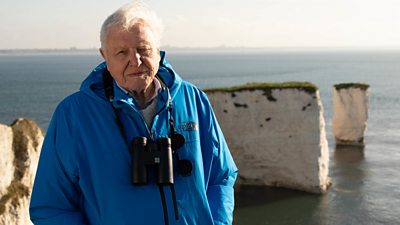
Britain and Ireland have some of the most diverse wildlife and beautiful landscapes on Earth. In this major new landmark series, Sir David Attenborough will celebrate the wonders of the islands that we call home, revealing the surprising and dramatic habitats that exist right on our doorstep. It’s our home, as you’ve never seen it before.
Filmed over the course of three years, this new five-part series will investigate how our woodland, grassland, freshwater and ocean habitats support wildlife of all kinds. Using the very latest technology, each episode will capture dramatic and new behaviour across the British Isles, from battling butterflies to mighty killer whales on the hunt.
Nature in our islands will prove just as spectacular as anywhere else on the planet, but it is increasingly fragile. With intricately connected species relying on habitats, and one another, for survival, we ask what can be done to protect them and the delicate ecosystems that remain, and to make our wild isles even wilder for future generations.
AT2
Interview with Alastair Fothergill (Series Producer)
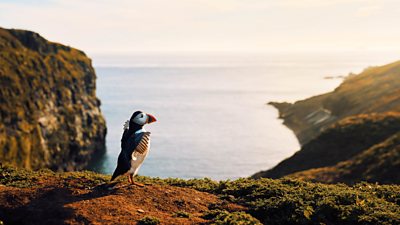
Why did you decide to focus on the British Isles for this series?
Ever since I worked on the original Blue Planet, Planet Earth and Frozen Planet series, I have always wanted to cover the British Isles and our natural history with a similarly ambitious and epic approach. I knew that nobody had ever had the opportunity before to really do justice to the spectacular scenery and rich and varied wildlife found at home. I also have a personal passion for our natural history.
What would you hope that the audience will take away from watching the series?
I hope the audience will be genuinely surprised by the richness of our natural history. At the same time, I hope they will recognise how fragile and precious it is.
Why are Britain and Ireland globally important for nature?
There are a number of reasons. Firstly, we have among the most varied geology on the planet. Our temperatures range from subtropical in the far south to arctic conditions on the top of the Cairngorms in Scotland. Our coastline is over 22,000 miles long and we benefit from the warming effect of the Gulf Stream. Our position on the globe is perfect for summer visitors from the south and winter visitors from the north. All these factors combine to create one of the richest natural histories in Europe. We have more ancient oak trees than the whole of Europe put together*, most of the world’s chalk streams flow in southern England and we are globally important for the sea birds.
How was it travelling around the British Isles for this series?
I was very fortunate to travel round the country directing the pieces to camera with Sir David Attenborough. We filmed it in a variety of different locations, but the highlights for me were two visits to the island of Skomer, off west Wales. I first worked with David back in 1987 and it felt a great privilege to be in the field with him again.
The series films lots of different species, are there any that really stuck in your mind?
There are so many amazing sequences in this series, it's very hard to choose. I have particularly enjoyed some of the epic sequences like white-tailed eagles hunting barnacle geese on the island of Islay (this is the first time the whole hunting sequence has been filmed), red deer stags battling in southern Ireland or peregrine falcons hunting knot on the Wash. The series is also full of more intimate, close-up stories like leeches hunting baby toads, an amazing bee that rides on a broomstick and the extraordinary life cycle of the large blue butterfly.
There are various technologies being used to film this series, can you tell us about some of these?
Drones have played a critical role capturing the spectacular landscape of the British Isles. Thermal cameras have revealed foxes hunting rabbits at night and captured the extraordinary spectacle of thousands of starlings coming in to roost. Stabilised cameras have allowed us to film orca hunting seals at sea and wild horses battling for their females. Underwater, specially developed technology has brought the sea bed to life with time lapse and captured in intimate detail the lives of plankton.
Hopefully the series will encourage the audience to interact with their local wildlife – what are your tips for people so they can do this responsibly?
I’d encourage people to go to the BBC Wild Isles website and there will be a link with a rich variety of suggestions of what people can do to enjoy their local wildlife.
Series Stats
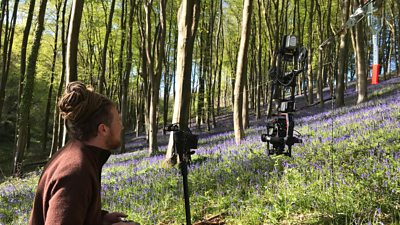
Total Shoots: 200 (over 3 years)
Filming Days
- Our Precious Isles - 382
- Woodland - 286
- Grassland - 322
- Freshwater - 369
- Ocean - 273
Total - 1631
- Across the 5 episodes, the crew filmed in 145 locations over 3 years.
- Across the 5 episodes, the crew filmed 96 species.
Longest shoot by sequence (cumulative days on location over multiple periods):
- Salmon – 71 days
- Eagles & Geese – 65 days
- Tuna – 57 days
Longest individual shoots
- Shetland (orca, otters & gannets) – 35 consecutive days
- Tuna – 34 consecutive days
- Beavers – 30 consecutive days
Highest point filmed was just off the summit of Cairngorm which is 1,245m high
Sir David Attenborough attended six filming locations
- Old Harry Rocks, in Dorset, to introduce the series
- Richmond Park to introduce Woodland
- A hay meadow in Dorset to introduce Grassland
- A chalk stream in Wiltshire to introduce Freshwater
- Green Bridge on the Pembrokeshire Coast to introduce Ocean
- Skomer Island, off Pembrokeshire, to do the closing piece for Our Precious Isles and Ocean
Episode One - Our Precious Isles
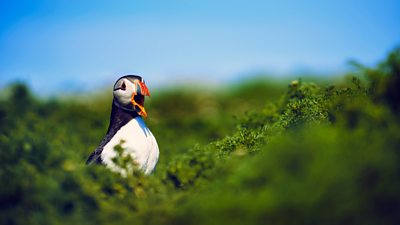
Sir David Attenborough celebrates the rich variety of wildlife that exists in the British Isles and explains why our small and uniquely positioned set of isles are so critical for the survival of species from right across the globe.
Filmed in extraordinary detail across the country, we see new behaviour from animals we think we know well, and from others whose existence here may come as a surprise. Killer whales hunt for seals in our seas, rare golden eagles scavenge in snowy mountains, puffins are chased by greedy gulls that try to steal their hard-won catch and sinister woodland plants hold unsuspecting insects hostage.
Britain and Ireland are also revealed as a globally important destination for tens of thousands of migrating birds. Each year on the east coast of Scotland, 75,000 pairs of gannets arrive on Bass Rock to nest*, forming the biggest colony of northern gannets in the world. On the west coast, abundant food and a mild climate attract enormous flocks of barnacle geese which travel to Islay to feed on the lush grass, but they must watch out for white-tailed eagles that have learnt to hunt them down.
One reason for Britain and Ireland’s natural wealth is its geology, which is among the most diverse on the planet. It ranges from the chalk formations of southern England to the limestone pavements of Yorkshire, and from the rugged granite of Northumberland to the volcanic basalt of the Giant’s Causeway in Northern Ireland. Another reason our British Isles are so diverse is due to the great range in temperature, from the subtropical conditions in the south to the frozen Arctic conditions of the Cairngorms in the north. From the varied rocks and minerals across our fluctuating isles, unique habitats have arisen.
Despite these rich and varied habitats, Britain and Ireland are among the most nature-depleted countries in the world. From a busy puffin colony, Sir David Attenborough highlights this issue and asks how we can restore our once wild isles for future generations.
Key Stories
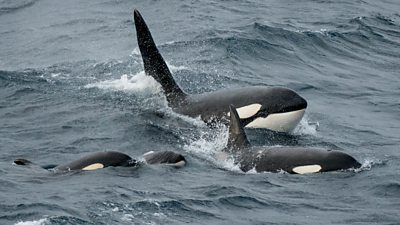
New/Remarkable Behaviour
Lords and ladies plant pollination – filmed in Bristol, this plant heats up and releases a foul-smelling scent that is irresistible to flies, tricking them to enter its flower. The fly lands on a slippery leaf and slides down, becoming trapped inside. The plant keeps it hostage before showering the fly with pollen then allowing it to escape.
The team had to make tiny windows in the sides of the flowers to film the structures within. Thermal cameras captured glowing images of plants heating up to lure in the flies and the team could also feel the heat by placing their face next to the plant. It required carefully timed observation, as each plant heats up for just four hours before it starts to wilt the following day.
Camerawoman Katie Mayhew said: “Surprisingly the ripe flowers only stayed hot for a few hours during their life cycle and at their hottest they really did smell - you could even feel the heat by touch. Capturing the colour to thermal transitional shots was a complicated task, like filming a puzzle. First, we captured a series of images on a low light colour camera which we then could stitch together to create a very large image. Then we had to capture exactly to the sequence of images with the thermal camera so that the overall stitched images from the colour and thermal would match. These master images could then be transitioned from colour to thermal to take the viewer from what we humans see and what really is going on with the flower.”
Filming Feat/Remarkable Behaviour
White-tailed eagles hunting geese – first time the whole hunting sequence has been filmed. White-tailed eagles have a two-metre wingspan and are the largest bird of prey in Britain. Formerly extinct in the British Isles, around a dozen now spend winter in Islay. Britain is listed as the worst country in the G7 for wildlife and wild spaces lost due to human activity*, but these eagles are a good example of how the restoration of habitats and the reintroduction of species has enabled us to film behaviours once lost to our isles*.
Capturing the whole hunt required a co-ordinated team of specialist long lens camera people and wildlife spotters. The white-tailed eagles ranged over vast areas, so the team had to keep in close communication working in hides positioned at eagle hot spots around Islay. It took several trips and more than 70 days filming.
Filming Feat/Remarkable Behaviour
Orca - Britain’s largest marine predator, can reach lengths of almost 10 metres and weigh up to 10 tonnes. Shetland is the only place in the British Isles where orca breed. We filmed a remarkable feeding strategy in which the orca appear to go silent as they approach the seals, in an apparent attempt not to scare them off.
The team filmed this footage over three years using drones and specialist camera equipment on board their boat. The crew were in contact with a group of about 250 local people who helped them to trace the orca along the coast and were able to film the hunt in its entirety.
Interview with Hilary Jeffkins (Series Producer & Episode One Producer)
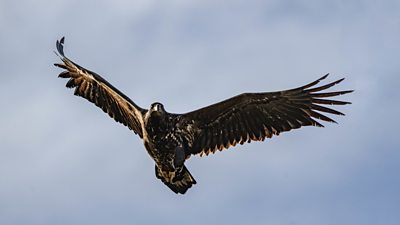
What would you hope that the audience will take away from watching the series?
I hope that after watching this series our audience will be wowed by the wildlife and spectacular places in Britain and Ireland but also that they get a strong sense of how fragmented and fragile they are. I want the audience to come away with a sense of pride and hope for the future too.
Why are Britain and Ireland globally important for nature?
Surprisingly, Britain and Ireland have some of the most diverse geology in the world and this bed rock has given us varied and unique habitats with some very precious wildlife. We are custodians to more than 50% of the world’s common bluebells and we have 85% of the worlds chalk streams*. Also, our position on the globe means that our isles are key places for migratory species that stop off to feed and breed – in the summer we are home to the world’s biggest colony of Northern gannets, 75,000 breeding pairs, and every year huge numbers of barnacle geese migrate our way to find food. This makes us globally important for nature. But despite this we are still one of least biodiverse countries in the world, making it important that we protect and restore the wildlife we have*.
Do you think people will engage with the extraordinary wildlife on our doorsteps as much as they have withnatural history programmes about other parts of the world?
I think that people will be surprised by the wildlife on their own doorsteps and amazed by the behaviour. It is quite shocking to think that we have pods of killer whales, top predators, hunting seals in our seas and a large blue butterfly that tricks ants into caring for its caterpillars, by using deceptive sounds and smells. The wildlife that we think we know well still has some extraordinary hidden stories.
In Episode 1 there's a scene where you filmed barnacle geese who come to a Hebridean island in the autumn and are hunted by white-tailed eagles. Can you tell us about how you filmed that scene?
White-tailed eagles hunting is a behaviour rarely seen in the wild and only snippets of this had ever been filmed before. Capturing the whole story required a co-ordinated team of specialist long lens cameramen and wildlife spotters. This included top wildlife cameramen John Aitchison, Jesse Wilkinson and Hamza Yassin. The white-tailed eagles ranged over vast areas on the island and beyond, so the team had to keep in close communication via walkie talkies, working for long hours in hides positioned at eagle hot spots around Islay. It took several trips and more than 70 days filming to capture the first ever complete sequence of wild white-tailed eagles hunting barnacle geese.
You also filmed Lords and Ladies plants that release a foul-smelling scent to attracts flies, what technology did you use for this scene?
We used a tiny amount of timelapse to speed up the pollen when it was bursting out of the flower and the rest of the sequence was shot in real time over several days. Filming the flowers of Lords and Ladies was a challenge. The team, including world expert macro cameraman Alastair MacEwen, used specially developed lenses, and had to make tiny windows in the sides of the flowers to be able to see the structures within. Thermal cameras were used to capture glowing images of the spadix when it was heating up to lure in the flies. Pinpointing the exact time to film a hot flower was tricky! Each one only heated up for just one evening before it started to wilt the following day. A combination of carefully timed observation, plus the smell and warm feel of the flower when near our skin helped track them down. But it was worth the effort to see the woodland look like it was peppered with tiny candles.
Filming Locations & Species Filmed (Episode One)
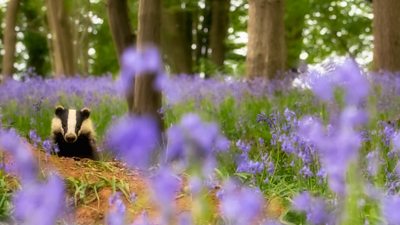
Orca & seals: Shetland Isles
Diverse geology: Cumbria; Lake District; Dorset; Scottish Highlands; Skye; Yorkshire Dales; North Pennines; Giant’s Causeway, Northern Ireland
Arctic Britain & golden eagle: Scottish Highlands
Ancient oaks & dormouse: Oxfordshire; Sussex
Badgers & bluebells: Oxfordshire; Somerset; Avon; Kent
Meadows & pollinators: Avon; Gloucestershire; Wiltshire
Foxes: Gloucestershire
White-tailed eagles & geese: Islay
Demoiselles: Somerset
Kingfishers & chalk streams: River Stour; River Avon; River Frome
Bass Rock gannets: Bass Rock; Firth of Forth
Puffins & gulls: Farne Islands, Northumberland; Skomer Island, Pembrokeshire
Thoughts from Wild Isles Co-Producers
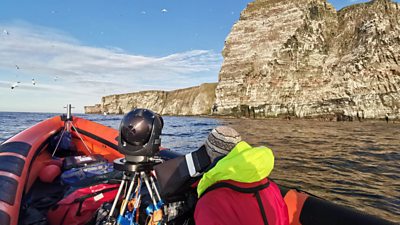
Tanya Steele, Chief Executive of WWF, says:
“WWF has been honoured to play a key role in creating the Wild Isles series, along with our co-producers the RSPB and The Open University. Along with other generous sources, our experts provided science and expertise behind the themes and species covered. We know nature in the UK is in crisis and we hope this series will highlight that we all have a role to play in protecting and restoring it, now and for generations to come. We can bring our world back to life.”
Beccy Speight, CEO of RSPB, says:
“All of us at the RSPB have felt so privileged to contribute alongside our fellow co-producers WWF and The Open University. Wild Isles is a once-in-a-generation celebration of UK wildlife, but it’s also a stark warning of how much we have to lose. Our experts were among those who provided guiding science and advice, as well as offering our amazing reserves to film everything from dragonflies to golden eagles. We can’t wait to see what action is sparked by this milestone series - nature is in crisis, but we know that together we can save it.”
Dr Philip Wheeler, Senior Lecturer in Ecology at the Open University, says:
“As an academic consultant on Wild Isles, I have been lucky enough to contribute to the series' production and help ensure that as well as amazing footage, the stories that are told are informed by our current understanding of the ecology of the wildlife of Britain and Ireland. There is also a strong conservation message that runs through the series and that is needed more than ever now as our natural environment continues to be under threat. Hopefully this series will help inspire the next generation of nature enthusiasts, researchers and conservationists to protect our precious wildlife.”
About WWF
WWF is a global environmental charity bringing our world back to life. With nature in freefall, we’re urgently tackling the underlying causes that are driving decline and finding solutions so future generations have a world with thriving habitats and wildlife. wwf.org.uk
About the RSPB
The RSPB is protecting habitats, saving species and helping to end the nature and climate emergency. Nature is in crisis. Together we can save it. www.rspb.org.uk
About the Open University
The Open University (OU) is the largest academic institution in the UK and a world leader in flexible distance learning and has taught more than 2.2 million students worldwide. The OU has had a unique educational partnership with the BBC since 1971 and recent co-productions include The Green Planet, Panorama: Will the NHS care for me?, Art That Made Us and We Are Black and British. www.open.ac.uk
Team Biographies
Alastair Fothergill – Series Producer
Alastair left the BBC in late 2012 to set up Silverback Films. He was the Executive Producer of a new landmark series for BBC One, The Hunt, which looks at the dynamic relationships between predators and their prey, and Producer of a 3D Giant Screen version of the series, Incredible Predators. He is the Co-Director of Disneynature’s Monkey Kingdom released in 2015, of Penguin released in 2019 and co-directed Polar Bear for Disneynature to be released in April 2022. Alastair was a Series Producer for Netflix’s first landmark natural history series Our Planet, which was released globally in April 2019, a Director for David Attenborough: A Life On our Planet, released on Netflix in 2020, and an Executive Producer for the BBC One series A Perfect Planet which aired in January 2021, as well as the Netflix feature Breaking Boundaries, released in June 2021.
Alastair is a Fellow of the Royal Geographic Society and was awarded their gold medal in 2012. He has honorary doctorates from the Universities of Bristol, Durham and Hull. In 2017 Alastair was the BBC Grierson Trustees’ Award winner and he was awarded the OBE in the Queen’s Birthday Honours List 2019 for his services to Film.
Hilary Jeffkins - Series Producer and Producer of Episode 1 (Our Precious Isles)
Hilary Jeffkins is a keen naturalist and award-winning wildlife Filmmaker, Producer and Director. After graduating from York St John University with a BSc in Biology she joined the BBC Natural History Unit and worked there for over 25 years. In her early career she produced and developed live programmes, including Heading South, Wild Britain and Bird in the Nest, precursors to Springwatch. She has worked with film crews in Britain and abroad, in the field and in studios to produce a variety of programmes including the Really Wild Show (BAFTA), Wildlife on One, Bill Oddie Goes Wild and David Attenborough’s Life in Cold Blood (BAFTA).
In 2011 she became freelance and worked for Humblebee Films, writing, producing, and directing on three series of David Attenborough’s Natural Curiosities. She joined Silverback Films in 2017 and a year later started the development of the Wild Isles series. For the past three years she has worked as Series Producer and has also produced the opening episode Wild Isles – Our Precious Isles. Hilary lives in Bristol. She can be found mostly outdoors, walking, watching British wildlife and planting trees.
Chris Howard – Producer of Episode 2 (Woodland) and Episode 4 (Freshwater)
After attaining his Zoology BSc at the University of Edinburgh, Chris had no idea what to do with it so moved to Bristol to see whether working in natural history television might be the answer. He worked on several BBC children’s series before landing his dream job on Springwatch. He worked his way up through the ranks, picking up other work on live productions such as Planet Earth Live, Big Cat Live and Big Blue Live, before taking two years in London to work in the Science Unit and on a 3D film about pterosaurs with Sir David Attenborough. He then returned to Bristol, leading the development and launch of the BBC’s first natural history YouTube channel before eventually returning to his spiritual home as producer and then series producer of Springwatch. For the last three years, Chris has been working on Wild Isles.
Nicholas Gates – Producer of Episode 3 (Grassland)
For Producer Nicholas Gates, a lifelong naturalist, the opportunity to work on a blue-chip series about the wildlife of Britain and Ireland was a huge career goal. Nicholas has worked in natural history television for a decade, on shows ranging from The One Show to Springwatch, to international series for National Geographic and Animal Planet, but he has a particular soft spot for nature “at home” here. Nicholas hopes that this series will surprise the public with the extraordinary wildlife spectacles here in Britain and Ireland, highlight how threatened much of our nature is and encourage people to help restore it for future generations. Outside of his television work, Nicholas is also a published author and keen wildlife gardener.
Gisle Sverdrup – Producer of Episode 5 (Ocean)
Gisle Sverdrup is a natural history filmmaker specialising in programmes about the underwater world. His passion for the oceans has previously seen him film all around the world, working on major projects for the BBC, Netflix and Disney. He combines his knowledge of biology and technology to find engaging stories and tell them in new and exciting ways, often using equipment developed specifically for each project.
Credits
Joint Series Producers
Alastair Fothergill
Hilary Jeffkins
Episode 1 Producer
Hilary Jeffkins
Pan BBC nature content

To accompany Wild Isles, through the Spring and Summer across the BBC there is a major focus on nature, designed to deepen audiences’ understanding and inspire them to get involved.
BBC Radio 2 with BBC Children’s and Education, supported by The One Show and others, are launching Let it Grow – an initiative to turn grey spaces into wild and colourful places, with a focus on tempting even the least green fingered to join in. Blue Peter viewers can earn their Blue Peter Green badges by getting involved and there will also be an OZT Goes Wild in Britain special on domestic wildlife. BBC Sport will be highlighting grassroots clubs up and down the country doing great work in preserving and promoting nature – as well as reflecting what is happening at the elite level – challenging more to get involved.
Sunday Morning Live will be turning the spotlight on how churchyards, as well as other religious spaces, can make a difference.Countryfile will be showing audiences how to do their bit to help save wildlife with Wild Britain, following on from their hugely successful Plant Britain initiative. And BBC drama series, Doctors, is celebrating the launch of Wild Isles by devoting a storyline to the team rallying to save a wildlife corridor that is under threat of development.
The BBC will be inviting local communities to Get Into Nature, be that for their mental or physical health, for their community, for the environment or simply for fun. BBC Wales, Scotland and Northern Ireland will also be reflecting the focus on nature in their output.
And to escape the challenges of the day to day, without even needing to leave their own home, audiences can immerse themselves in Radio 3’s The Sounds of the BBC’s Wild Isles podcast.
To accompany the activity on-air, the BBC has worked in partnership with multiple external organisations, including Art Fund, Girlguiding, the National Trust, RHS, Scouts and The Wildlife Trusts, who have created real world opportunities, activities and events for audiences to directly experience nature. A dedicated website www.bbc.co.uk/wildisles will host details, along with additional resources and branding for community groups who want to get involved and hold their own ‘Inspired by Wild Isles’ event.
Pan BBC sustainability
Environmental and sustainability issues have long been reflected in the content we make and broadcast, so it’s important to us that they are also embedded in the way we operate and run the BBC.
We are working on solutions to reduce greenhouse gas (GHG) emissions within our own industry, protect the biodiversity of the world we interact with, while also enhancing our audiences’ understanding of climate change and what’s needed to transition to Net Zero.
Our aim is to meet the Science Based Targets (SBTs), set in October 2021, to cut our GHG emissions to Net Zero and which are in line with staying below the threshold of 1.5 degrees of global warming.
We’re also focussed on protecting the natural world around us. Currently, we’re aligning to a framework set out by the Taskforce for Nature-related Financial Disclosures (TNFD) which guides organisations in reporting on the risks from biodiversity loss and ecosystem degradation. As part of the project, the BBC is investigating its own operational impact on the environment and we have conducted an initial bio-diversity footprint study, in conjunction with a specialist team from the University of Oxford.
More details on our work to become a Net Zero broadcaster are available on the BBC’s Sustainability website.
Notes to Editors
- We have more ancient oak trees than the whole of Europe put together [Source: Hebrian Plants, Oxford University]
- 75,000 pairs of gannets arrive on Bass Rock to nest [Source: Scottish Seabird Centre]
- Britain is listed as the worst country in the G7 for wildlife and wild spaces lost due to human activity [Source: Natural History Museum]
- White-tailed eagles are a good example of how the restoration of habitats and the reintroduction of species has enabled us to film lost behaviours [Source: The Wildlife Trusts]
- We are custodians to more than 50% of the world’s common bluebells and we have 85% of the worlds chalk streams [Bluebells source: The Wildlife Trusts] [Chalk stream source: WWF]
- We are still one of least biodiverse countries in the world, making it important that we protect and restore the wildlife we have [Source: Biodiversity Intactness Study]